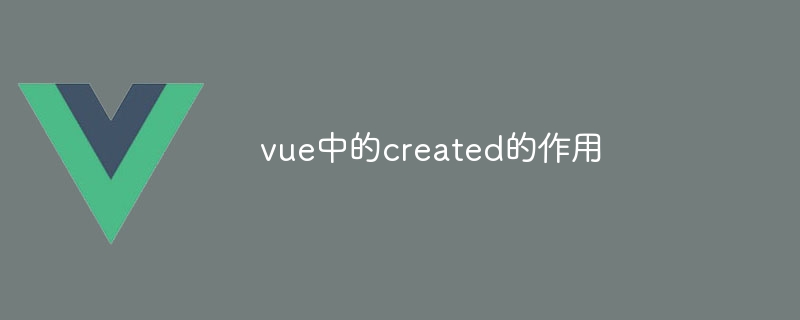The role of created in vue
The created life cycle hook in Vue will be executed when the instance is created. Its functions include: 1. Data initialization, setting data before template rendering; 2. Initiating asynchronous operations to ensure completion before rendering; 3. Configuration Element, add event listener or style class before rendering; 4. Set watch listener to monitor data attribute changes.

The role of the created life cycle hook in Vue
The created life cycle hookwill be in Called when a Vue instance is created, it is executed between the data() and mounted() lifecycle hooks. Its function is as follows:
1. Perform data initialization
created life cycle hook is an ideal place to initialize data. It is called before the template is rendered, so any data set or updated in created will be available in the template. For example:
created() {
this.message = 'Hello, Vue!';
}2. Initiate asynchronous operations
created Lifecycle hooks can also be used to initiate asynchronous operations, such as sending network requests or getting data from the backend. It ensures that these operations are completed before the template is rendered, thus avoiding loading delays. For example:
created() {
axios.get('/api/data').then(response => {
this.data = response.data;
});
}3. Configuring elements
created Lifecycle hooks can also be used to configure DOM elements, such as setting up event listeners or adding style classes. This allows these configurations to be applied before the template is rendered, thus improving performance. For example:
created() {
window.addEventListener('scroll', this.onScroll);
}
methods: {
onScroll() {
// 滚动处理逻辑
}
}4. Set watch listener
created Life cycle hook can also be used to set watch listener, that is, to monitor changes in data attributes. This allows you to perform specific actions when data changes, such as validating or triggering other actions. For example:
created() {
this.$watch('message', (newValue, oldValue) => {
// 在 message 发生变化时执行特定操作
});
}In short, the created life cycle hook is an important stage in the Vue instance creation process. It is used to initialize data, initiate asynchronous operations, configure elements and set watch listeners.
The above is the detailed content of The role of created in vue. For more information, please follow other related articles on the PHP Chinese website!

Hot AI Tools

Undresser.AI Undress
AI-powered app for creating realistic nude photos

AI Clothes Remover
Online AI tool for removing clothes from photos.

Undress AI Tool
Undress images for free

Clothoff.io
AI clothes remover

Video Face Swap
Swap faces in any video effortlessly with our completely free AI face swap tool!

Hot Article

Hot Tools

Notepad++7.3.1
Easy-to-use and free code editor

SublimeText3 Chinese version
Chinese version, very easy to use

Zend Studio 13.0.1
Powerful PHP integrated development environment

Dreamweaver CS6
Visual web development tools

SublimeText3 Mac version
God-level code editing software (SublimeText3)

Hot Topics
 1658
1658
 14
14
 1415
1415
 52
52
 1309
1309
 25
25
 1257
1257
 29
29
 1231
1231
 24
24
 How to use bootstrap in vue
Apr 07, 2025 pm 11:33 PM
How to use bootstrap in vue
Apr 07, 2025 pm 11:33 PM
Using Bootstrap in Vue.js is divided into five steps: Install Bootstrap. Import Bootstrap in main.js. Use the Bootstrap component directly in the template. Optional: Custom style. Optional: Use plug-ins.
 How to add functions to buttons for vue
Apr 08, 2025 am 08:51 AM
How to add functions to buttons for vue
Apr 08, 2025 am 08:51 AM
You can add a function to the Vue button by binding the button in the HTML template to a method. Define the method and write function logic in the Vue instance.
 How to use watch in vue
Apr 07, 2025 pm 11:36 PM
How to use watch in vue
Apr 07, 2025 pm 11:36 PM
The watch option in Vue.js allows developers to listen for changes in specific data. When the data changes, watch triggers a callback function to perform update views or other tasks. Its configuration options include immediate, which specifies whether to execute a callback immediately, and deep, which specifies whether to recursively listen to changes to objects or arrays.
 What does vue multi-page development mean?
Apr 07, 2025 pm 11:57 PM
What does vue multi-page development mean?
Apr 07, 2025 pm 11:57 PM
Vue multi-page development is a way to build applications using the Vue.js framework, where the application is divided into separate pages: Code Maintenance: Splitting the application into multiple pages can make the code easier to manage and maintain. Modularity: Each page can be used as a separate module for easy reuse and replacement. Simple routing: Navigation between pages can be managed through simple routing configuration. SEO Optimization: Each page has its own URL, which helps SEO.
 How to return to previous page by vue
Apr 07, 2025 pm 11:30 PM
How to return to previous page by vue
Apr 07, 2025 pm 11:30 PM
Vue.js has four methods to return to the previous page: $router.go(-1)$router.back() uses <router-link to="/" component window.history.back(), and the method selection depends on the scene.
 How to use vue traversal
Apr 07, 2025 pm 11:48 PM
How to use vue traversal
Apr 07, 2025 pm 11:48 PM
There are three common methods for Vue.js to traverse arrays and objects: the v-for directive is used to traverse each element and render templates; the v-bind directive can be used with v-for to dynamically set attribute values for each element; and the .map method can convert array elements into new arrays.
 React vs. Vue: Which Framework Does Netflix Use?
Apr 14, 2025 am 12:19 AM
React vs. Vue: Which Framework Does Netflix Use?
Apr 14, 2025 am 12:19 AM
Netflixusesacustomframeworkcalled"Gibbon"builtonReact,notReactorVuedirectly.1)TeamExperience:Choosebasedonfamiliarity.2)ProjectComplexity:Vueforsimplerprojects,Reactforcomplexones.3)CustomizationNeeds:Reactoffersmoreflexibility.4)Ecosystema
 How to reference js file with vue.js
Apr 07, 2025 pm 11:27 PM
How to reference js file with vue.js
Apr 07, 2025 pm 11:27 PM
There are three ways to refer to JS files in Vue.js: directly specify the path using the <script> tag;; dynamic import using the mounted() lifecycle hook; and importing through the Vuex state management library.




